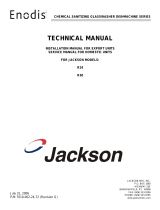Page is loading ...


3
REVISION
REVISION
DATE
MADE
BY
APPLICABLE
ECN
DETAILS
A 06-14-04 CBW 7080
Updated instructions to new format; was part number 05700-002-
24-93.

4
RETROFIT INSTRUCTIONS FOR OLD-STYLE FLOAT SWITCH
WARNING: Inspection, testing and repair of electrical equipment should only be performed by a qualified
service technician. Many of the tests require that the unit have power to it and live electrical components be
exposed. USE EXTREME CAUTION WHEN TESTING THE MACHINE.
1. Turn of machine. The power button for the machine is indicated as Item A in the figure above. In addition to turning the power
off at the power switch, power must be secured at the service breaker. Lock out and tag out the service breaker to ensure that
power is not accidentally restored to the unit during the retrofit process. Before beginning any work, verify that there is no
electrical power coming to the dishmachine!
2. Secure water to the dishmachine. If your WH-44 model has a manual shut-off valve (refer to Item C in the figure above) then
shut that valve as well. Item C above shows the electric solenoid valve found on auto-fill models, but the manual fill valve should
be in the same relative location.
A
B
C

5
RETROFIT INSTRUCTIONS FOR OLD-STYLE FLOAT SWITCH (CONTINUED)
3. Completely drain the unit. Important: There must be no water left in the machine in order to perform this retrofit
process.
4. Remove the lower front heater box cover (Item B on the figure).
WARNING: Removing the heater box cover exposes potentially live electrical components. Ensure that
electrical power has been secured to the unit at the service breaker before attempting to work on any com-
ponents within the heater box.
5. Disconnect the float switch wires.
6. Remove the float switch assembly. Important: If you failed to drain the dishmachine as explained in step (3), then water
will being to flow from the float switch hole in the tub!
7. Install the new retrofit assembly through the existing hole. Ensure that the float switch itself is straight inside the tub. The
hole that the float switch goes through will require food grade sealant to seal the hole. Sealant should not be used excessive-
ly. Important: Sealant should be allowed to completely dry prior to filling dishmachine with water or else leaking may
occur. Note: the extra hole in the mounting bracket goes around the thermostat bulb in the tank.
8. Secure the float switch assembly in place.
9. Attach the two pigtailed wires from the new float switch to the wires disconnected in step (5).
10. After allowing sealant to dry, close all drains. Unlock the service breaker and turn back on. Unsecure water to the dishma-
chine.
11. Turn the machine back on and allow to fill. Verify that no water leaks from the new float assembly. If water does begin to
leak, immediately secure water flow and secure power at the service breaker. Lock out the service breaker before investigat-
ing the source of the leak. Important: Do not attempt to investigate a water leak in the heater box with the power on to
the machine! Correct the deficiency causing the water leak before proceeding to the next step.
12. With the water leak fixed and the machine filled to normal operating level, run an empty rack through the machine to put it
into a normal cycle.
13. To test that the float switch is functioning correctly perform the following test: (Important: this test requires live electrical
components be exposed. Use extreme caution in the perfomance of this test! Keep all unnecessary personnel away
from the dishmachine while this test is being performed!)
a. Slowly drain water from the dishmachine by opening the manual drain valve.
b. When the float is clear of the water (not floating), the heater contactor in the control box should not turn off.
14. If, for some reason, the unit fails the test, then there is a possibility that (1) the switch is wired incorrectly, (2) the heater
contactor is faulty, or (3) some other problem has arisen. Whatever the reason, the machine should not be turned back over to
the customer for normal operational use until it can pass the test in step (13).
15. Once the unit has passed all leak and operational tests, secure power at the service breaker once more and replace the
front cover. Close any other covers that may be open, remove all test equipment and clean the area of debris. Once complet-
ed, unsecure power to the unit and return it to normal operating condition.
/






